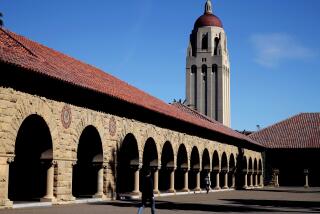Turning Citrus Groves to Pulp
- Share via
They call it Hogzilla. And it could be coming to an orchard near you.
With its whirling rows of hammer-like teeth, the mammoth wood grinder with the monster name has been chewing a swath through Ventura County’s agricultural heartland, devouring row upon row of old-growth citrus to make way for higher-value crops.
Since being unleashed nearly three years ago by Camarillo-based Maximum Engineering Inc., the machine has cleared hundreds of acres of county farmland, gobbling full-grown trees and spitting them out in a honey-colored cloud of wood chips and sawdust.
Its appetite has helped farmers keep up in an era of change as they scramble to replace old, tired orchards with crops better able to turn a profit in California’s increasingly competitive fruit and vegetable markets.
“A lot of these guys are up against a hard spot and a rock -- here they are trying to survive and they are forced into making these changes,” said Maximum Engineering’s President John Peters, who with partner George Gamboa brought Hogzilla to the county in 2001.
“The way the economy is going, they are having to make quick changes,” Peters said. “We are there to provide a service to make that possible for them.”
The change has been dramatic at times.
Reeling from seasons of little or no profit thanks to rising foreign competition coupled with shrinking demand, the county’s once-mighty orange industry has been in steady decline, with land dedicated to Valencias and navels dropping by nearly half in two decades.
In many cases, the acreage has been supplanted by nursery stock or vegetable crops. And much of the land has been cleared to make way for the expansion of the county’s new top cash crop, strawberries.
That transition has meant the removal of thousands of trees and left growers with the choice of waiting for a burn day to get rid of the remnants or finding a way to pulverize them.
Enter Hogzilla, a 60-ton portable processor that can reduce four acres of orchard into wood chips in just an hour.
Standing 14 feet high and 12 feet wide, the computer-controlled grinder draws stares and questions from onlookers whenever its throaty twin-turbine engine is fired up. And at 78 feet long, the machine needs a special Caltrans permit every time it is trucked to a job site.
The wood chips it produces are used by ranchers to fortify soil or sent to cogeneration plants in the Central Valley.
Hogzilla is the brand name for wood tub grinders made by C.W. Manufacturing of Kansas. Maximum Engineering paid $500,000 for its machine, the company’s top model and one of only a handful of its grinders in California, according to the manufacturer.
Although each job is negotiated individually, Peters said, growers pay an average of $5.25 per tree to feed his Hogzilla, at a rough average of 125 trees per acre.
Fourth-generation farmer John Broome saw Hogzilla at work one day and was so impressed that he arranged to have it uproot a 26-acre lemon orchard in Ventura, near the junction of the 101 Freeway and California 126. Broome wanted to replace the aging grove with a short-term crop until the land is developed.
“It was costing us just to keep that land in lemons, so rather than continuing to lose money on them we just gobbled them up,” said Broome, whose land was cleared in less than four days, each tree popped from the ground like a carrot and fed into the grinder roots first.
Veteran farmer John Borchard has used the grinding service three times as part of his orchard maintenance program, removing old citrus trees and replacing them with younger, more vibrant stock.
“It works good and it works fast,” Borchard said of the grinder, which has cleared about 75 acres for him. “It saves you a lot of time, and that is more valuable than anything today.”
Peters, 62, and Gamboa, 57, were looking to grind any kind of wood when they started. In fact, their first job was for a developer clearing land for a housing project.
But nearly all their business lately has come from farmers. The machine uprooted 500 acres of orchard last year and is expected to clear at least 2,000 acres this year in Ventura County and the San Joaquin Valley. Already this year it has munched on a Central Valley olive orchard being readied for an almond crop.
“John and I just happened to be at the right place at the right time,” Gamboa said.
The partners expect plenty of future projects for Hogzilla to sink its teeth into. Starting in June 2005, the state is phasing out agricultural waste-burning in the San Joaquin Valley under a new law designed to improve the region’s air quality. Peters and Gamboa said they could get plenty of business as a result.
Then there is the changing nature of agriculture, the constant effort by farmers to find new, moneymaking crops in the face of rising production costs and increased competition from around the globe.
“It kind of saddens me to see these orchards vanishing,” Peters said, “but agriculture is constantly changing.”
More to Read
Inside the business of entertainment
The Wide Shot brings you news, analysis and insights on everything from streaming wars to production — and what it all means for the future.
You may occasionally receive promotional content from the Los Angeles Times.










